Enhancing Height Predictions of Brazilian Pine for Mixed, Uneven-Aged Forests Using Artificial Neural Networks
Abstract
1. Introduction
2. Materials and Methods
2.1. Study Areas
2.2. Data
2.3. Modeling Using Artificial Neural Networks (ANNs)
2.4. Statistical Criteria
2.5. Comparison with Other Approaches
3. Results
4. Discussion
5. Conclusion
Supplementary Materials
Author Contributions
Funding
Institutional Review Board Statement
Informed Consent Statement
Data Availability Statement
Acknowledgments
Conflicts of Interest
References
- Reitz, R.; Klein, R.M. Flora Ilustrada Catarinense: Araucariáceas; Herbário Barbosa Rodrigues: Itajaí, Brazil, 1966. [Google Scholar]
- Higuchi, P.; Carolina, A.; Silva, D.A.; Sousa Ferreira, T.; Trierveiler, S.; Souza, D.E.; Pereira Gomes, J.; Montibeller, K.; Fiorentin, K.; Santos, D.O. Floristic Composition and Phytogeography of the Tree Component of Araucaria Forest Fragments in Southern Brazil. Braz. J. Bot. 2012, 35, 145–157. [Google Scholar] [CrossRef]
- Santana, L.D.; Ribeiro, J.H.C.; Ivanauskas, N.M.; Carvalho, F.A. Estrutura, Diversidade E Heterogeneidade De Uma Floresta Ombrófila Mista Altomontana Em Seu Extremo Norte De Distribuição (Minas Gerais). Ciência Florest. 2018, 28, 567–579. [Google Scholar] [CrossRef]
- Bauermann, S.G.; Behling, H. (Eds.) Dinâmica Paleovegetacional Da Floresta Com Araucária a Partir Do Final Do Pleistoceno: O Que Mostra a Palinologia. In Floresta Com Araucária: Ecologia, Conservação E Desenvolvimento Sustentável; Holos Editora: Ribeirão Preto, Brazil, 2009; pp. 35–38. [Google Scholar]
- Hess, A.F.F.; Loiola, T.; de Souza, I.A.; Minatti, M.; Ricken, P.; Borsoi, G.A. Forest management for the conservation of Araucaria angustifolia in Southern Brazil. FLORESTA 2018, 48, 373. [Google Scholar] [CrossRef]
- Costa, E.A.; Finger, C.A.G. Efeito Da Competição Nas Relações Dimensionais de Araucária. Floresta E Ambiente 2016, 24, e20150145. [Google Scholar] [CrossRef]
- Orellana, E.; Vanclay, J.K. Competition and Dominance between Angiosperms and Araucaria angustifolia (Bert.) O. Kuntze in the Atlantic Forest in Southern Brazil. For. Ecol. Manag. 2018, 425, 119–125. [Google Scholar] [CrossRef]
- Souza, I.D.A.; Hess, A.F.; Costa, E.A.; da Silveira, A.C.; Baldissera Schorr, L.P.; Atanazio, K.A. Development of Models to Aid Decision-Making in The Management of Araucaria angustifolia (Bertol.) Kuntze. FLORESTA 2020, 50, 1854. [Google Scholar] [CrossRef]
- Vivian, M.A.; Grosskopf, É.J.; Nunes, G.C.; Itako, A.T.; Modes, K.S. Qualidade e Eficiência de Produtos Naturais No Tratamento Preservativo Das Madeiras de Araucaria angustifolia, Eucalyptus Viminalis e Pinus Taeda. Rev. De Ciências Agroveterinárias 2020, 19, 35–47. [Google Scholar] [CrossRef][Green Version]
- Martins, D.A.P.; Erdmann, J.M.; Lemos, A.M.; Walter, F.F.; Lanzarini, A.C.; Kanieski, M.R. Espécies Potenciais Para Recuperação de Áreas Degradadas a Partir de Levantamento Florístico Realizado No Planalto Catarinense. Rev. De Ciências Agroveterinárias 2020, 18, 38–46. [Google Scholar] [CrossRef]
- Cysneiros, V.C.; Pelissari, A.L.; Gaui, T.D.; Fiorentin, L.D.; de Carvalho, D.C.; Silveira Filho, T.B.; Machado, S. do A. Modeling of Tree Height–Diameter Relationships in the Atlantic Forest: Effect of Forest Type on Tree Allometry. Can. J. For. Res. 2020, 50, 1289–1298. [Google Scholar] [CrossRef]
- Stankova, T.V.; Diéguez-Aranda, U. Height-Diameter Relationships for Scots Pine Plantation in Bulgaria: Optimal Combination of Model Type and Application. Ann. For. Res. 2013, 56, 149–163. [Google Scholar]
- Li, Y.; Deng, X.; Huang, Z.; Xiang, W.; Yan, W.; Lei, P.; Zhou, X.; Peng, C. Development and Evaluation of Models for the Relationship between Tree Height and Diameter at Breast Height for Chinese-Fir Plantations in Subtropical China. PLoS ONE 2015, 10, e0125118. [Google Scholar] [CrossRef]
- Kafuti, C.; van den Bulcke, J.; Beeckman, H.; van Acker, J.; Hubau, W.; de Mil, T.; Hatakiwe, H.; Djiofack, B.; Fayolle, A.; Loubota Panzou, G.J.; et al. Height-Diameter Allometric Equations of an Emergent Tree Species from the Congo Basin. For. Ecol. Manag. 2022, 504, 119822. [Google Scholar] [CrossRef]
- Otto, S. Die Abhängigkeit Des Hirngewichts von Dem Körpergewicht Und Den Geistigen Fähigkeiten. Arch. Psychiatr 1982, 23, 436–446. [Google Scholar]
- Skudnik, M.; Jevšenak, J. Artificial Neural Networks as an Alternative Method to Nonlinear Mixed-Effects Models for Tree Height Predictions. For. Ecol. Manag. 2022, 507, 120017. [Google Scholar] [CrossRef]
- Kindermann, G. Evaluation of Growth Functions for Tree Height Modelling. Austrian J. For. Sci. 2016, 133, 353–376. [Google Scholar]
- Calama, R.; Montero, G. Interregional Nonlinear Height-Diameter Model with Random Coefficients for Stone Pine in Spain. Can. J. For. Res. 2004, 34, 150–163. [Google Scholar] [CrossRef]
- Trincado, G.; VanderSchaaf, C.L.; Burkhart, H.E. Regional Mixed-Effects Height–Diameter Models for Loblolly Pine (Pinus Taeda L.) Plantations. Eur. J. For. Res. 2007, 126, 253–262. [Google Scholar] [CrossRef]
- Adame, P.; del Río, M.; Cañellas, I. A Mixed Nonlinear Height–Diameter Model for Pyrenean Oak (Quercus Pyrenaica Willd.). For. Ecol. Manag. 2008, 256, 88–98. [Google Scholar] [CrossRef]
- Costa, E.A.; Hess, A.F.; Klein, D.R.; Finger, C.A.G. Height-Diameter Models for Araucaria angustifolia (Bertol.) Kuntze in Natural Forests. J. Agric. Sci. 2018, 10, 133. [Google Scholar] [CrossRef]
- Özçelik, R.; Cao, Q.V.; Trincado, G.; Göçer, N. Predicting Tree Height from Tree Diameter and Dominant Height Using Mixed-Effects and Quantile Regression Models for Two Species in Turkey. For. Ecol. Manag. 2018, 419–420, 240–248. [Google Scholar] [CrossRef]
- Hofiço, N.S.A.; Costa, E.A.; Fleig, F.D.; Finger, C.A.G.; Hess, A.F. Height-Diameter Relationships For Eucalyptus Grandis Hill Ex. Maiden In Mozambique: Using Mixed-Effects Modeling Approach. Cerne 2020, 26, 183–192. [Google Scholar] [CrossRef]
- Özçelik, R.; Diamantopoulou, M.J.; Brooks, J.R.; Wiant, H.V. Estimating Tree Bole Volume Using Artificial Neural Network Models for Four Species in Turkey. J. Environ. Manag. 2010, 91, 742–753. [Google Scholar] [CrossRef] [PubMed]
- Tiryaki, S.; Aydın, A. An Artificial Neural Network Model for Predicting Compression Strength of Heat Treated Woods and Comparison with a Multiple Linear Regression Model. Constr. Build. Mater. 2014, 62, 102–108. [Google Scholar] [CrossRef]
- Vahedi, A.A. Artificial Neural Network Application in Comparison with Modeling Allometric Equations for Predicting Above-Ground Biomass in the Hyrcanian Mixed-Beech Forests of Iran. Biomass Bioenergy 2016, 88, 66–76. [Google Scholar] [CrossRef]
- Batista, T.S.; Teodoro, L.P.R.; de Azevedo, G.B.; Azevedo, G.T.D.O.S.; Poersch, N.L.; Borges, M.V.V.; Teodoro, P.E. Artificial Neural Networks and Non-Linear Regression for Quantifying the Wood Volume in Eucalyptus Species. South. For. A J. For. Sci. 2022, 84, 1–7. [Google Scholar] [CrossRef]
- Júnior, I.D.S.T.; de Souza, J.R.M.; Lopes, L.S.D.S.; Fardin, L.P.; Casas, G.G.; Neto, R.R.D.O.; Leite, R.V.; Leite, H.G. Machine Learning and Regression Models to Predict Multiple Tree Stem Volumes for Teak. South. For. A J. For. Sci. 2021, 83, 294–302. [Google Scholar] [CrossRef]
- Binoti, M.L.M.D.S.; Binoti, D.H.B.; Leite, H.G.; da Silva, A.A.L.; Pontes, C. Utilização de Redes Neurais Artificiais Para a Projeção Da Distribuição Diamétrica de Povoamento Equiâneos. Rev. Árvore 2014, 38, 747–754. [Google Scholar] [CrossRef]
- Binoti, M.L.M.D.S.; Binoti, D.H.B.; Leite, H.G. Aplicação de Redes Neurais Artificiais Para Estimação Da Altura de Povoamentos Equiâneos de Eucalipto. Rev. Árvore 2013, 37, 639–645. [Google Scholar] [CrossRef]
- Gonçalves, S.B.; Fiedler, N.C.; Silva, J.P.M.; da Silva, G.F.; da Silva, M.L.M.; Minette, L.J.; Pereira, D.P.; Lopes, D.M.M.; da Silva, E.F.; Ramalho, A.H.C.; et al. Machine Learning Techniques to Estimate Mechanised Forest Cutting Productivity. South. For. A J. For. Sci. 2021, 83, 276–283. [Google Scholar] [CrossRef]
- Castaño-Santamaría, J.; Crecente-Campo, F.; Fernández-Martínez, J.L.; Barrio-Anta, M.; Obeso, J.R. Tree Height Prediction Approaches for Uneven-Aged Beech Forests in Northwestern Spain. For. Ecol. Manag. 2013, 307, 63–73. [Google Scholar] [CrossRef]
- Bayat, M.; Bettinger, P.; Heidari, S.; Khalyani, A.H.; Jourgholami, M.; Hamidi, S.K. Estimation of Tree Heights in an Uneven-Aged, Mixed Forest in Northern Iran Using Artificial Intelligence and Empirical Models. Forests 2020, 11, 324. [Google Scholar] [CrossRef]
- Costa, E.A.; Liesenberg, V.; Finger, C.A.G.; Hess, A.F.; Schons, C.T. Understanding Bark Thickness Variations for Araucaria angustifolia in Southern Brazil. J. For. Res. 2021, 32, 1077–1087. [Google Scholar] [CrossRef]
- Barbosa, L.O.; Costa, E.A.; Schons, C.T.; Finger, C.A.G.; Liesenberg, V.; Bispo, P.D.C. Individual Tree Basal Area Increment Models for Brazilian Pine (Araucaria angustifolia) Using Artificial Neural Networks. Forests 2022, 13, 1108. [Google Scholar] [CrossRef]
- Schmidt, M.; Kiviste, A.; von Gadow, K. A Spatially Explicit Height–Diameter Model for Scots Pine in Estonia. Eur. J. For. Res. 2011, 130, 303–315. [Google Scholar] [CrossRef]
- Haykin, S. Neural Networks: A Comprehensive Foundation, 2nd ed.; Prentice-Hall: Englewood Cliffs, NJ, USA, 1999. [Google Scholar]
- Özkan, C.; Erbek, F.S. The Comparison of Activation Functions for Multispectral Landsat Tm Image Classification. Photogramm. Eng. Remote Sens. 2003, 69, 1225–1234. [Google Scholar] [CrossRef]
- Carrijo, J.V.N.; Ferreira, A.B.D.; Ferreira, M.C.; de Aguiar, M.C.; Miguel, E.P.; Matricardi, E.A.T.; Rezende, A.V. The Growth and Production Modeling of Individual Trees Of Eucalyptus Urophylla plantations. J. For. Res. 2020, 31, 1663–1672. [Google Scholar] [CrossRef]
- Ayalakshmi, T.; Santhakumaran, A. Statistical Normalization and Back Propagation for Classification. Int. J. Comput. Theory Eng. 2011, 3, 1793–8201. [Google Scholar]
- Igwe, K.C.; Oyedum, O.D.; Ajewole, M.O.; Aibinu, A.M. Received Signal Strength Computation for Broadcast Services Using Artificial Neural Network. In Proceedings of the 2017 13th International Conference on Electronics, Computer and Computation (ICECCO), Abuja, Nigeria, 28–29 November 2017; pp. 1–6. [Google Scholar]
- Alvares, C.A.; Stape, J.L.; Sentelhas, P.C.; de Moraes Gonçalves, J.L.; Sparovek, G. Köppen’s Climate Classification Map for Brazil. Meteorol. Z. 2013, 22, 711–728. [Google Scholar] [CrossRef]
- Patton, M. Qualitative Research and Evaluation Methods, 3rd ed.; Sage Publications: Thousand Oaks, CA, USA, 2002. [Google Scholar]
- Costa, E.A.; Liesenberg, V.; Hess, A.F.; Finger, C.G.; Schneider, P.R.; Longhi, R.V.; Schons, C.; Borsoi, G.A. Simulating Araucaria angustifolia (Bertol.) Kuntze Timber Stocks With Liocourt’s Law in a Natural Forest in Southern Brazil. Forests 2020, 11, 339. [Google Scholar] [CrossRef]
- Hess, A.F.; Minatti, M.; Costa, E.A.; Schorr, L.P.B.; da Rosa, G.T.; de Arruda Souza, I.; Borsoi, G.A.; Liesenberg, V.; Stepka, T.F.; Abatti, R. Height-to-Diameter Ratios with Temporal and Dendro/Morphometric Variables for Brazilian Pine in South Brazil. J. For. Res. 2021, 32, 191–202. [Google Scholar] [CrossRef]
- Barbosa, L.O.; Finger, C.A.G.; Costa, E.A.; Campoe, O.C.; Schons, C.T. Using Crown Characterisation Variables as Indicators of the Vigour, Competition and Growth of Brazilian Pine. South. For. A J. For. Sci. 2021, 83, 240–253. [Google Scholar] [CrossRef]
- Costa, E.A.; Finger, C.A.G.; Cunha, T.A. Influência Da Posição Sociológica Na Relação Hipsométrica de Araucaria angustifolia. Rev. Bras. De Ciências Agrárias-Braz. J. Agric. Sci. 2014, 9, 110–116. [Google Scholar] [CrossRef]
- Bourque, C.P.-A.; Bayat, M.; Zhang, C. An Assessment of Height–Diameter Growth Variation in an Unmanaged Fagus Orientalis-Dominated Forest. Eur. J. For. Res. 2019, 138, 607–621. [Google Scholar] [CrossRef]
- Salehnasab, A.; Bayat, M.; Namiranian, M.; Khaleghi, B.; Omid, M.; Masood Awan, H.U.; Al-Ansari, N.; Jaafari, A. Machine Learning for the Estimation of Diameter Increment in Mixed and Uneven-Aged Forests. Sustainability 2022, 14, 3386. [Google Scholar] [CrossRef]
- Tiryaki, S.; Hamzaçebi, C. Predicting Modulus of Rupture (MOR) and Modulus of Elasticity (MOE) of Heat Treated Woods by Artificial Neural Networks. Measurement 2014, 49, 266–274. [Google Scholar] [CrossRef]
- Hamidi, S.K.; Zenner, E.K.; Bayat, M.; Fallah, A. Analysis of Plot-Level Volume Increment Models Developed from Machine Learning Methods Applied to an Uneven-Aged Mixed Forest. Ann. For. Sci. 2021, 78, 4. [Google Scholar] [CrossRef]
- Bayat, M.; Bettinger, P.; Hassani, M.; Heidari, S. Ten-Year Estimation of Oriental Beech (Fagus Orientalis Lipsky) Volume Increment in Natural Forests: A Comparison of an Artificial Neural Networks Model, Multiple Linear Regression and Actual Increment. For. Int. J. For. Res. 2021, 94, 598–609. [Google Scholar] [CrossRef]
- Haykin, S. Neural Networks and Learning Machines; Prentice Hall: Hoboken, NJ, USA, 2009. [Google Scholar]
- Wang, Y.; Li, Y.; Song, Y.; Rong, X. The Influence of the Activation Function in a Convolution Neural Network Model of Facial Expression Recognition. Appl. Sci. 2020, 10, 1897. [Google Scholar] [CrossRef]
- Suszyński, M.; Peta, K. Assembly Sequence Planning Using Artificial Neural Networks for Mechanical Parts Based on Selected Criteria. Appl. Sci. 2021, 11, 10414. [Google Scholar] [CrossRef]
- Wang, X.; Ren, H.; Wang, A. Smish: A Novel Activation Function for Deep Learning Methods. Electronics 2022, 11, 540. [Google Scholar] [CrossRef]
- Goodfellow, Y.; Bengio, Y.; Courville, A. Deep Learning; MIT Press: Cambridge, MA, USA, 2016. [Google Scholar]
- Silva, I.N.; Spatti, D.H.; Flauzino, R.A. Redes Neurais Artificiais: Para Engenharia E Ciências Aplicadas; ARTLIBER: São Paulo, Brazil, 2010. [Google Scholar]
- Fritsch, S.; Guenther, F.; Wright, M.N.R.; Suling, M.; Mueller, S.M. Package ‘Neuralnet’, R package version 1.44.2; 2019. Available online: https://github.com/bips-hb/neuralnet (accessed on 1 July 2022).
- Corne, S.A.; Carver, S.J.; Kunin, W.E.; Lennon, J.J.; van Hees, W.W.V. Predicting Forest Attributes in Southeast Alaska Using Artificial Neural Networks. For. Sci. 2004, 50, 259–276. [Google Scholar]
- Vendruscolo, D.G.S.; Drescher, R.; Souza, H.S.; Moura, J.P.V.M.; Mamoré, F.M.D.; Siqueira, T.A.D.S. Estimativa Da Altura De Eucalipto Por Meio De Regressão Não Linear E Redes Neurais Artificiais. Rev. Bras. Biom. 2015, 33, 5565–5569. [Google Scholar]
- Chiarello, F.; Steiner, M.T.A.; De Oliveira, E.B.; Arce, J.E.; Ferreira, J.C. Artificial Neural Networks Applied In Forest Biometrics And Modeling: State Of The Art. CERNE 2019, 25, 140–155. [Google Scholar] [CrossRef]
- Costa, E.A.; Finger, C.A.G.; Hess, A.F. Competition Indices and Their Relationship With Basal Area Increment of Araucaria. J. Agric. Sci. 2018, 10, 198. [Google Scholar] [CrossRef]
- Cassol, H.L.G.; Shimabukuro, Y.E.; Carreiras, J.M.D.B.; Moraes, E.C. Improved Tree Height Estimation of Secondary Forests in the Brazilian Amazon. Acta Amaz. 2018, 48, 179–190. [Google Scholar] [CrossRef]
- Ou, Q.; Lei, X.; Shen, C. Individual Tree Diameter Growth Models of Larch–Spruce–Fir Mixed Forests Based on Machine Learning Algorithms. Forests 2019, 10, 187. [Google Scholar] [CrossRef]
- Ashraf, M.I.; Meng, F.-R.; Bourque, C.P.-A.; MacLean, D.A. A Novel Modelling Approach for Predicting Forest Growth and Yield under Climate Change. PLoS ONE 2015, 10, e0132066. [Google Scholar] [CrossRef]
- Ying, X. An Overview of Overfitting and Its Solutions. J. Phys. Conf. Ser. 2019, 1168, 22022. [Google Scholar] [CrossRef]
- Benitez, J.M.; Castro, J.L.; Requena, I. Are Artificial Neural Networks Black Boxes? IEEE Trans. Neural Netw. 1997, 8, 1156–1164. [Google Scholar] [CrossRef]
- Qiu, F.; Jensen, J.R. Opening the Black Box of Neural Networks for Remote Sensing Image Classification. Int. J. Remote Sens. 2004, 25, 1749–1768. [Google Scholar] [CrossRef]
- Bhering, L.L.; Cruz, C.D.; Peixoto, L.D.A.; Rosado, A.M.; Laviola, B.G.; Nascimento, M. Application of Neural Networks to Predict Volume in Eucalyptus. Crop Breed. Appl. Biotechnol. 2015, 15, 125–131. [Google Scholar] [CrossRef]
- Silva-Ribeiro, R.B.D.; Gama, J.R.V.; Souza, A.L.D.; Leite, H.G.; Soares, C.P.B.; Silva, G.F.D. Métodos para estimar o volume de fustes e galhos na Floresta Nacional Do Tapajós1. Rev. Árvore 2016, 40, 81–88. [Google Scholar] [CrossRef]
- Mosaffaei, Z.; Jahani, A. Modeling of Ash (Fraxinus Excelsior) Bark Thickness in Urban Forests Using Artificial Neural Network (ANN) and Regression Models. Modeling Earth Syst. Environ. 2021, 7, 1443–1452. [Google Scholar] [CrossRef]
- Şenyurt, M.; Ercanlı, İ.; Günlü, A.; Bolat, F.; Bulut, S. Artificial Neural Network Models for Predicting Relationships between Diameter at Breast Height and Stump Diameter: Crimean Pine Stands at ÇAKÜ Forest. Bosque 2020, 41, 25–34. [Google Scholar] [CrossRef]
- Ashraf, M.I.; Zhao, Z.; Bourque, C.P.-A.; MacLean, D.A.; Meng, F.-R. Integrating Biophysical Controls in Forest Growth and Yield Predictions with Artificial Intelligence Technology. Can. J. For. Res. 2013, 43, 1162–1171. [Google Scholar] [CrossRef]
- Tavares Júnior, I.D.S.; Torres, C.M.M.E.; Leite, H.G.; De Castro, N.L.M.; Soares, C.P.B.; Castro, R.V.O.; Farias, A.A. Machine Learning: Modeling Increment in Diameter of Individual Trees on Atlantic Forest Fragments. Ecol. Indic. 2020, 117, 106685. [Google Scholar] [CrossRef]
- Vendruscolo, D.G.S.; Chaves, A.G.S.; Medeiros, R.A.; Da Silva, R.S.; Souza, H.S.; Drescher, R.; Leite, H.G. Estimativa Da Altura de Árvores de Tectona Grandis, L.f. Utilizando Regressão e Redes Neurais Artificiais. Nativa 2017, 5, 52–58. [Google Scholar] [CrossRef][Green Version]
- Dantas, D.; Rodrigues Pinto, L.O.; Terra, M.D.C.N.S.; Calegario, N.; De Oliveira, M.L.R. Reduction of Sampling Intensity in Forest Inventories to Estimate the Total Height of Eucalyptus Trees. Bosque 2020, 41, 353–364. [Google Scholar] [CrossRef]
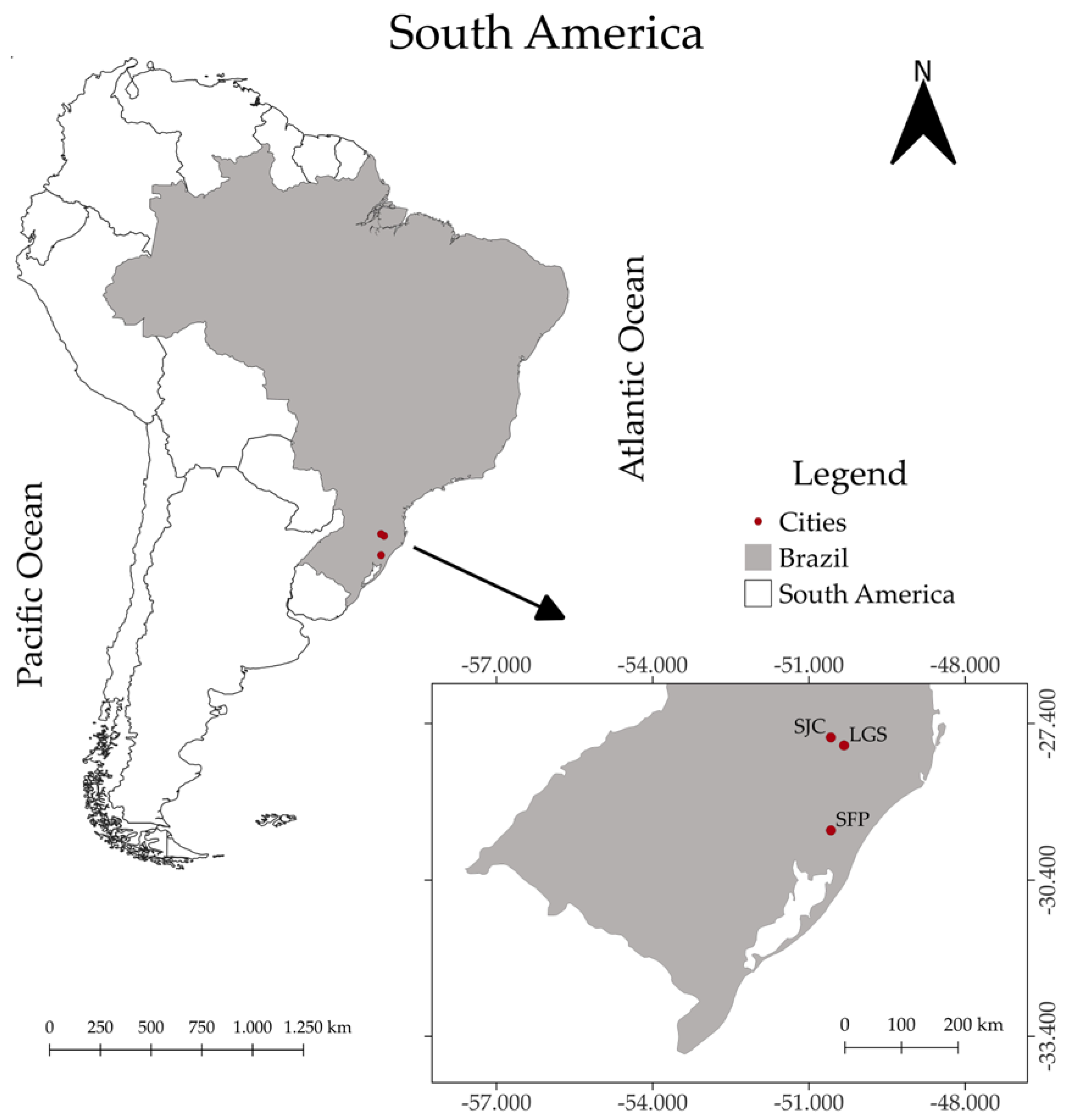
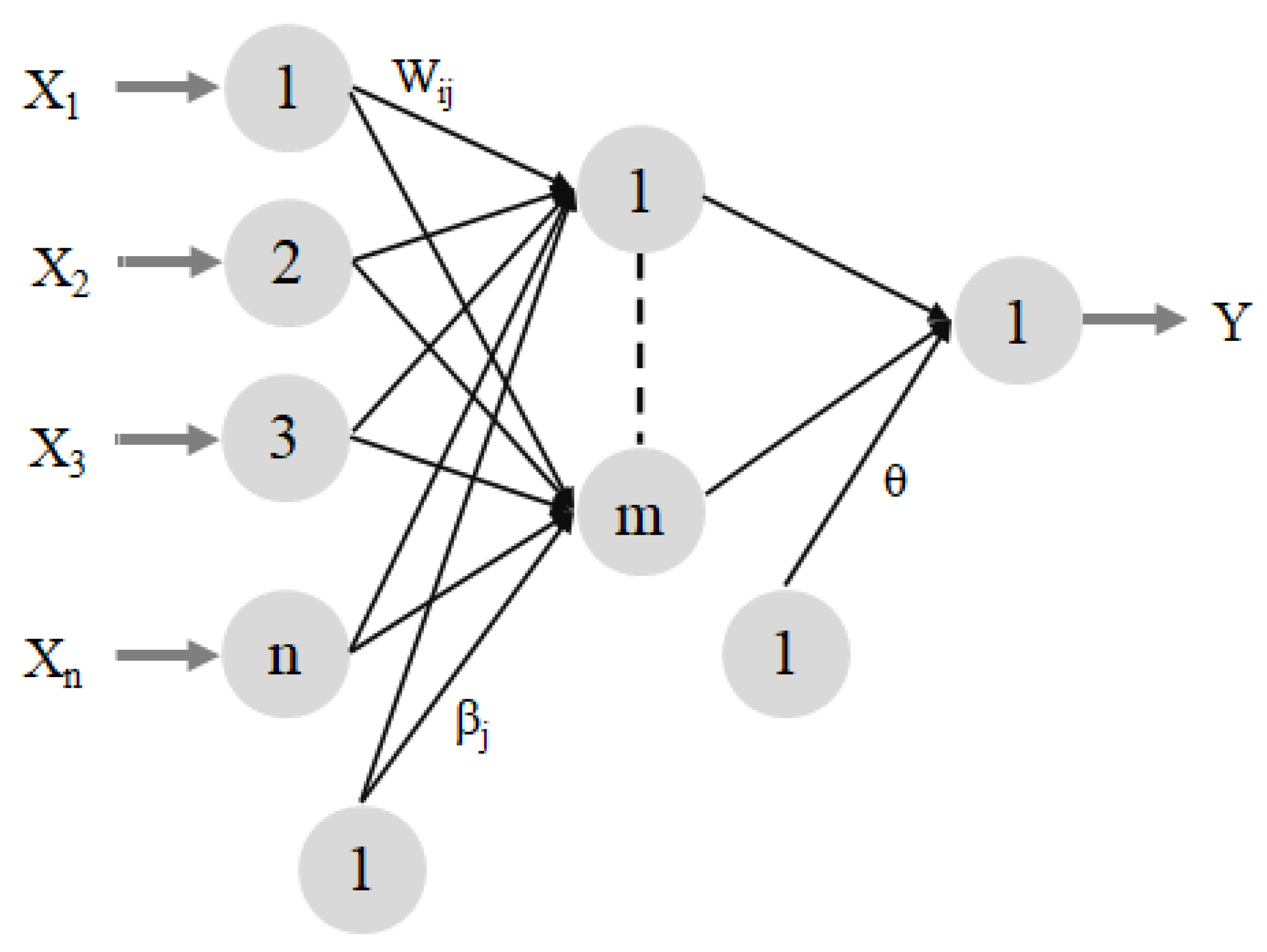
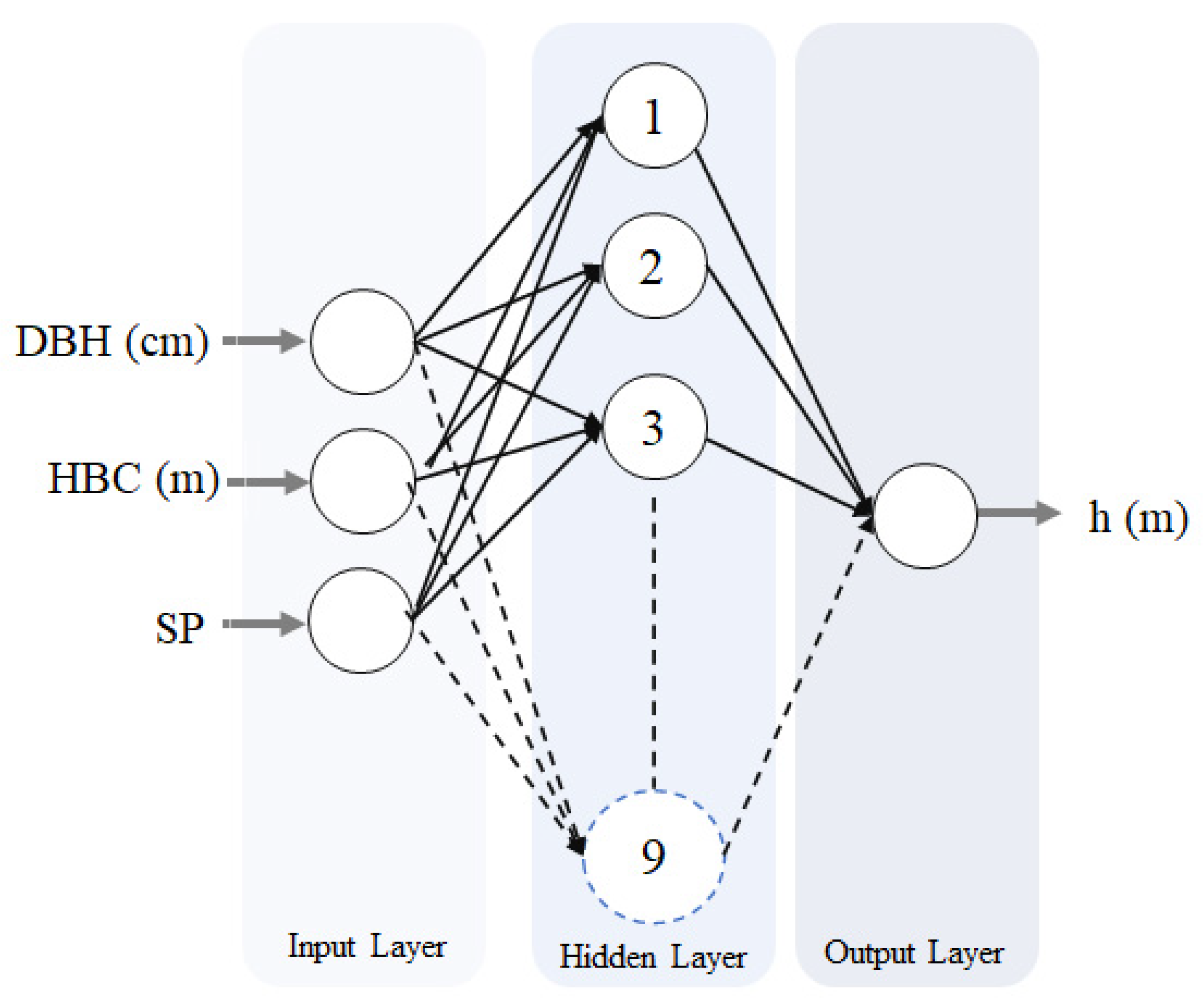
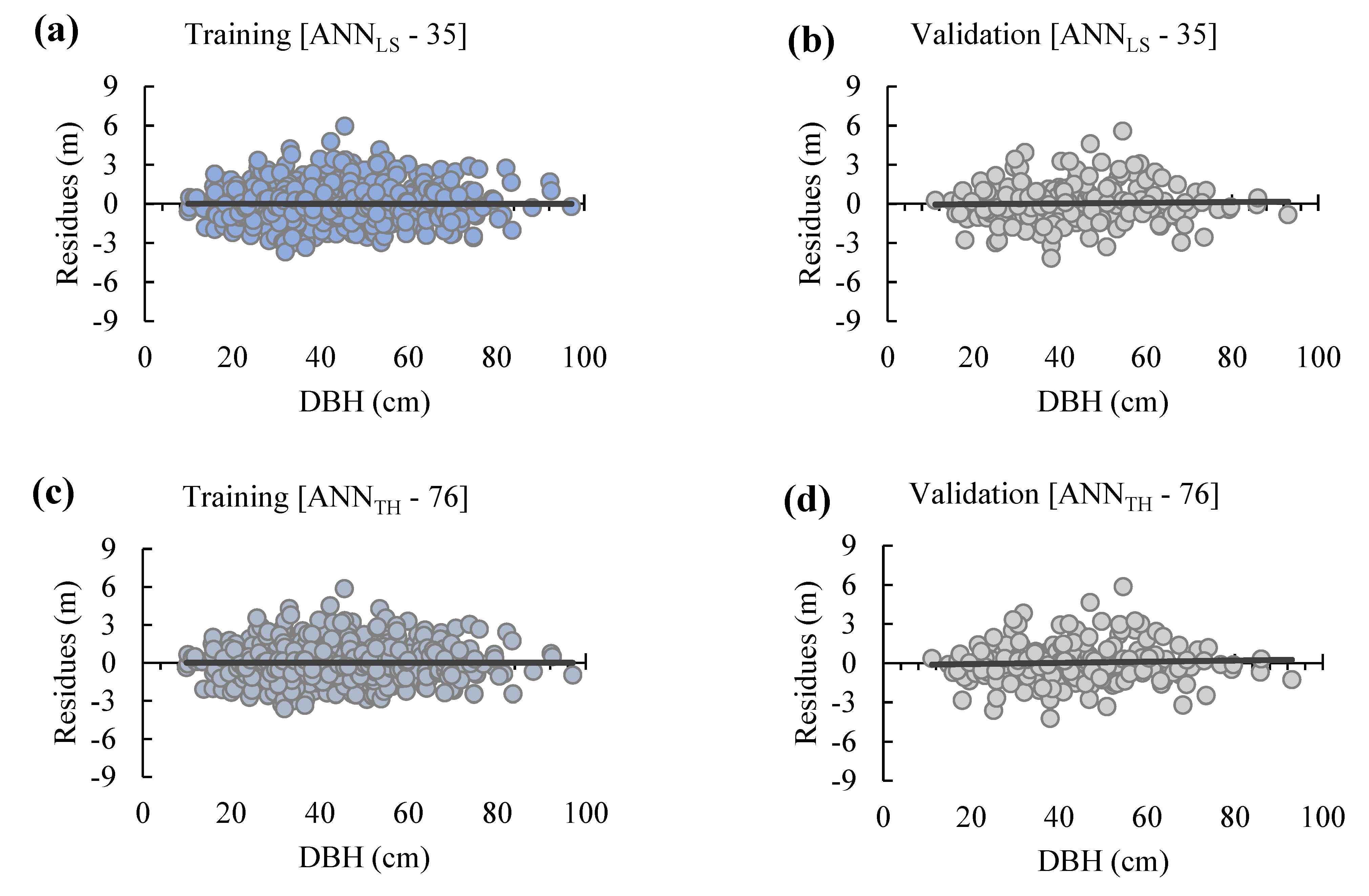
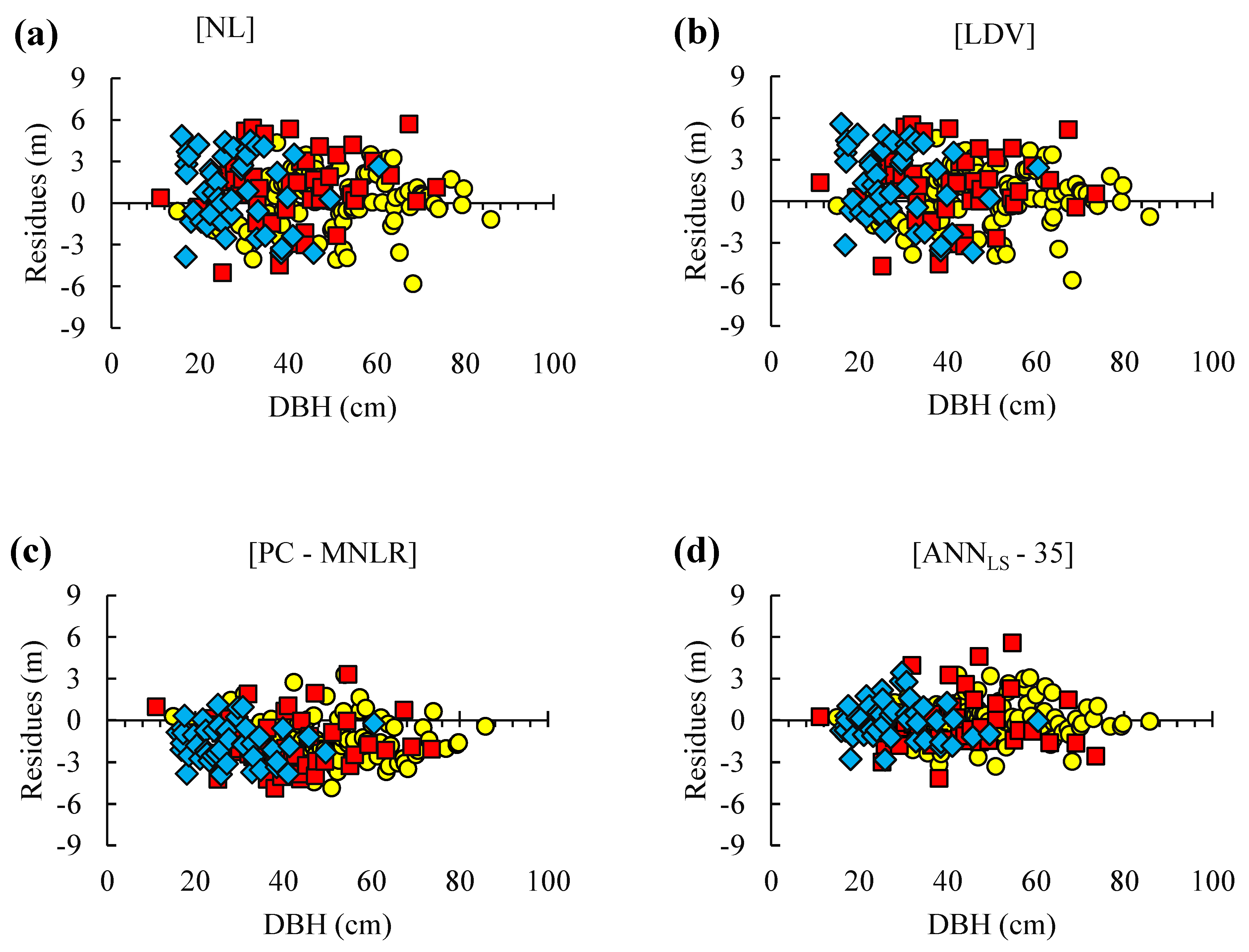
| City | State | Latitude | Longitude | Altitude | MAT | AP |
|---|---|---|---|---|---|---|
| Lages (LGS) | SC | 27°49′ S | 50°19′ W | 986.8 | 15.2 | 1684.7 |
| São José do Cerrito (SJC) | SC | 27°39′ S | 50°34′ W | 888.0 | 16.0 | 1690.0 |
| São Francisco de Paula (SFP) | RS | 29°26′ S | 50°34′ W | 853.8 | 15.0 | 2016.4 |
| Variables | Data | Minimum | Mean | Maximum | Standard Deviation |
|---|---|---|---|---|---|
| DBH | Training [N = 603] | 9.9 | 42.2 | 97.1 | 16.2 |
| HCB | 3.0 | 12.8 | 22.3 | 3.9 | |
| SP | 1.0 | 1.7 | 3.0 | 0.8 | |
| h | 7.2 | 17.5 | 25.1 | 3.4 | |
| DBH | Validation [N = 201] | 11.1 | 42.5 | 93.0 | 16.2 |
| HCB | 3.2 | 13.2 | 20.1 | 3.7 | |
| SP | 1.0 | 1.7 | 3.0 | 0.8 | |
| h | 8.4 | 17.8 | 24.8 | 3.3 |
| Data Normalization | Activation Function in the Hidden Layer | Architecture | ANNs | Training | Validation | |||||||
|---|---|---|---|---|---|---|---|---|---|---|---|---|
| R2 | RMSE | MAE | MAPE | R2 | RMSE | MAE | MAPE | t (p-Value) | ||||
| [0, 1] | Logistic Sigmoid | 3-3-1 | 87 | 0.83 | 1.42 | 1.10 | 6.54 | 0.80 | 1.47 | 1.12 | 6.54 | 0.3669 |
| 3-4-1 | 151 | 0.84 | 1.38 | 1.08 | 6.45 | 0.80 | 1.47 | 1.10 | 6.46 | 0.3669 | ||
| 3-5-1 | 133 | 0.84 | 1.37 | 1.07 | 6.35 | 0.80 | 1.48 | 1.10 | 6.44 | 0.3222 | ||
| 3-6-1 | 35 | 0.84 | 1.36 | 1.06 | 6.29 | 0.80 | 1.49 | 1.12 | 6.53 | 0.3925 | ||
| 3-7-1 | 112 | 0.85 | 1.34 | 1.04 | 6.13 | 0.78 | 1.57 | 1.18 | 6.94 | 0.2157 | ||
| 3-8-1 | 2 | 0.85 | 1.33 | 1.03 | 6.11 | 0.79 | 1.54 | 1.15 | 6.82 | 0.2076 | ||
| 3-9-1 | 27 | 0.85 | 1.33 | 1.04 | 6.17 | 0.78 | 1.56 | 1.19 | 7.18 | 0.2782 | ||
| [−1, 1] | Tangent Hyperbolic | 3-3-1 | 63 | 0.83 | 1.42 | 1.10 | 6.54 | 0.80 | 1.47 | 1.12 | 6.54 | 0.3669 |
| 3-4-1 | 186 | 0.83 | 1.38 | 1.08 | 6.47 | 0.80 | 1.48 | 1.10 | 6.47 | 0.3776 | ||
| 3-5-1 | 142 | 0.84 | 1.36 | 1.06 | 6.32 | 0.79 | 1.51 | 1.13 | 6.62 | 0.3595 | ||
| 3-6-1 | 76 | 0.84 | 1.36 | 1.05 | 6.27 | 0.80 | 1.48 | 1.11 | 6.43 | 0.3926 | ||
| 3-7-1 | 21 | 0.84 | 1.35 | 1.05 | 6.25 | 0.79 | 1.52 | 1.14 | 6.78 | 0.3688 | ||
| 3-8-1 | 85 | 0.85 | 1.32 | 1.03 | 6.11 | 0.78 | 1.55 | 1.20 | 7.13 | 0.3583 | ||
| 3-9-1 | 88 | 0.85 | 1.32 | 1.03 | 6.10 | 0.78 | 1.55 | 1.18 | 6.91 | 0.4455 | ||
| Output | Description | Symbology | Parameters * |
|---|---|---|---|
| h [ANNLS–35] | Connection weight between the i-th input neuron and the j-th neuron of the hidden layer | w11 | 3.32816051171092 |
| w12 | 5.63564847455494 | ||
| w13 | −4.40653201913032 | ||
| w14 | 2.68858077614371 | ||
| w15 | −1.68221666104095 | ||
| w21 | −3.24989570960590 | ||
| w22 | −5.77536858770656 | ||
| w23 | 3.87689105761618 | ||
| w24 | −1.13376891107571 | ||
| w25 | 1.25838992740362 | ||
| w31 | −321.30491714453200 | ||
| w32 | −381.40410414733300 | ||
| w33 | 86.20493085148810 | ||
| w34 | 88.90641991865460 | ||
| w35 | 21.61783043205750 | ||
| w41 | −22.89030349033760 | ||
| w42 | 410.83399462375600 | ||
| w43 | 0.50990767756676 | ||
| w44 | −125.55254893517100 | ||
| w45 | −36.36394357853860 | ||
| w51 | 3.94323030362454 | ||
| w52 | 5.80007401299029 | ||
| w53 | −0.78654999414145 | ||
| w54 | 0.20965400755131 | ||
| w55 | −0.14330472749885 | ||
| w61 | 4.07529360272997 | ||
| w62 | 6.59876667861121 | ||
| w63 | −0.08872791410663 | ||
| w64 | −2.17397149230597 | ||
| w65 | 0.68803696120158 | ||
| Bias value of the j-th neuron of the hidden layer | β1 | −3.50954443727372 | |
| β2 | 4.05439213215968 | ||
| β3 | 196.62632091995300 | ||
| β4 | −161.28176733076100 | ||
| β5 | −0.68610189401701 | ||
| β6 | −1.58674993359591 | ||
| Connection weights | v1 | −10.01973417076710 | |
| v2 | −10.27312884996830 | ||
| v3 | 0.09861299114926 | ||
| v4 | 0.04642360435809 | ||
| v5 | 8.18137541276566 | ||
| v6 | −6.94837517016951 | ||
| Bias value of the output neuron | θ | 9.71477261782129 |
| Type | Social Position | CL b | Validation * | ||
|---|---|---|---|---|---|
| RMSE | MAE | MAPE | |||
| NL a | SP1 | 1.95 | 1.55 | 8.69 | |
| SP2 | 2.71 | 2.18 | 12.47 | ||
| SP3 | 2.74 | 2.37 | 14.97 | ||
| LDV a | SP1, SP2, SP3 | D1, D2 | 2.41 | 1.93 | 11.21 |
| PC-MNLR a | 2.12 | 1.78 | 10.52 | ||
| ANNLS-35 | 1.49 | 1.13 | 6.57 | ||
Publisher’s Note: MDPI stays neutral with regard to jurisdictional claims in published maps and institutional affiliations. |
© 2022 by the authors. Licensee MDPI, Basel, Switzerland. This article is an open access article distributed under the terms and conditions of the Creative Commons Attribution (CC BY) license (https://creativecommons.org/licenses/by/4.0/).
Share and Cite
Costa, E.A.; Hess, A.F.; Finger, C.A.G.; Schons, C.T.; Klein, D.R.; Barbosa, L.O.; Borsoi, G.A.; Liesenberg, V.; Bispo, P.d.C. Enhancing Height Predictions of Brazilian Pine for Mixed, Uneven-Aged Forests Using Artificial Neural Networks. Forests 2022, 13, 1284. https://doi.org/10.3390/f13081284
Costa EA, Hess AF, Finger CAG, Schons CT, Klein DR, Barbosa LO, Borsoi GA, Liesenberg V, Bispo PdC. Enhancing Height Predictions of Brazilian Pine for Mixed, Uneven-Aged Forests Using Artificial Neural Networks. Forests. 2022; 13(8):1284. https://doi.org/10.3390/f13081284
Chicago/Turabian StyleCosta, Emanuel Arnoni, André Felipe Hess, César Augusto Guimarães Finger, Cristine Tagliapietra Schons, Danieli Regina Klein, Lorena Oliveira Barbosa, Geedre Adriano Borsoi, Veraldo Liesenberg, and Polyanna da Conceição Bispo. 2022. "Enhancing Height Predictions of Brazilian Pine for Mixed, Uneven-Aged Forests Using Artificial Neural Networks" Forests 13, no. 8: 1284. https://doi.org/10.3390/f13081284
APA StyleCosta, E. A., Hess, A. F., Finger, C. A. G., Schons, C. T., Klein, D. R., Barbosa, L. O., Borsoi, G. A., Liesenberg, V., & Bispo, P. d. C. (2022). Enhancing Height Predictions of Brazilian Pine for Mixed, Uneven-Aged Forests Using Artificial Neural Networks. Forests, 13(8), 1284. https://doi.org/10.3390/f13081284







